齐鲁武术: 孙膑拳举要
Qilu Martial Arts: Sun Bin Boxing’s Essentials/
by Wang Kaiwen (王开文)
第五章 孙膑拳举要
Chapter 5: Sun Bin Boxing’s Essentials
第一节 孙膑拳师承
Section 1: Sun Bin Boxing Masters
施德 (1794—1898年),字仲义,号逸翁,山东莱州人。精气功、拳械和医术,一生惟慎,择徒严谨,活至 104岁。虽多子 多孙也只选其一孙施仁方传承。施仁方 (1862 年—?) 传子施祥甫,施祥甫 (1890—1964年) 传子施俊祥,施俊祥传子施明。 施德收徒一男一女,男栾二公,女于秀莲 (后为儿媳,改名于娴助),皆为好友之后。
Shi De (施德; 1794-1898), courtesy name Zhong Yi (仲义) and nickname Yi Weng (逸翁), was born in Laizhou, Shandong. He was highly proficient in qigong, martial arts, and healing arts, and was also a meticulous, strict teacher who lived to 104. Despite having many children and grandchildren, he chose only his grandson, Shi Renfang (施仁方), to carry on his family’s martial legacy. Shi Renfang (1862-?) passed his skills on to his son, Shi Xiangfu (施祥甫), who passed them to his son, Shi Junxiang (施俊祥), and once again from Shi Junxiang to his son, Shi Ming (施明). Shi De accepted two disciples as well, a man named Luan Ergong (栾二公) and a woman named Yu Xiulian (于秀莲), who were all good friends.
栾二公,又名栾泽,山东莱州人,生卒年代不详。施德嫡授弟子,力大无穷,终身未娶。其堂侄栾秉信为人忠厚,常年在外赶脚(车把式)搞运输,为求防身,公将所学尽授之。侄在外又收山东东阿县张好春、张再春兄弟二人为徒(二张皆为车把式),其中一人收杨明斋为徒。
Luan Ergong (栾二公), also known as Luan Ze (栾泽), was from Laizhou, Shandong, but his date of birth and death are both unknown. As Shi De’s direct disciple, he was highly adept at martial arts yet never married. Since Luan Ergong’s nephew, Luan Bingxin (栾秉信), was a loyal and honest person who mostly worked on the street (as a carriage driver), he taught him everything he knew to help ensure that he could defend himself. Luan Bingxin also accepted two disciples—Zhang Haochun (张好春) and Zhang Zaichun (张再春) (both carriage drivers) from Dong’e, Shandong—of whom only Zhang Zaichun went on to have one disciple named Yang Mingzhai (杨明斋).
杨明斋 (1882—1942年),原名杨廷栋,山东阳谷县人。1917年出任山东武术传习所教习,打破门规,开课授艺。因在传习所运用此拳比武大获全胜,使孙膑拳蜚声武林。从1922年起任曲阜师范、青岛北京路小学国术教员。1926年继韩愧生之后主持青岛国技学社,为青岛国术馆创始人之一,兼任编辑科长、教师。1933年参加第17届华北运动会,获特别技能冠军。一生授徒甚众。1937年与青岛国术馆师生组织抗日义勇队奔赴前线。1942年在河南永城大柳庄对日阻击战中英勇牺牲。
Yang Mingzhai (杨明斋; 1882-1942), born Yang Tingdong (杨廷栋), was from Yanggu, Shandong. In 1917, he was appointed to teach martial arts at the Shandong Martial Arts Training Center (山东武术传习所教习), where he introduced innovative teaching methods. As someone known to win competitions by a landslide, his Sun Bin Boxing achieved celebrity status. From 1922 onward, he instructed martial arts at Qufu Normal University and Beijing Road Primary School in Qingdao. In 1926, following the death of Han Kuisheng (韩愧生), he succeeded him as head instructor of Qingdao’s National Sports Society. He was also one of the founders of the Qingdao Martial Arts Institute (QMAI), where he served as editor-in-chief and as a martial arts instructor. In 1933, he won first in the special skills category at the 17ᵗʰ North China Games (第17届华北运动会) and, throughout the course of his life, amassed a large number of disciples. In 1937, Yang and the teachers and students from QMAI organized an “anti-Japanese squad” (aka. “The Qingbao),” which fought the Japanese on the front lines. In 1942, he bravely sacrificed his life in an anti-Japanese battle in Daliu Village, Yongcheng, Henan.

Picture of Mr. Yang Mingzhai
高作霖 (1898—?) ,山东淄川人。1914 年从杨廷岳习弹腿。1915年从常秉义、常秉章习埋伏拳、少林拳,同年入山东武术传习所。1919—1928年又从杨明斋习孙膑拳。1928年起在青岛国术馆任教。1929年在浙江杭州国术游艺比赛大会上,参加擂台赛取得优等第二名,获赠宝剑一把。1930年应聘到山东国术馆任教,同年受省馆委派到临清国术馆任教。1932 年回青岛国术馆,新中国成立后,在淄川等地传授孙膑拳,晚年致力撰写回忆录,并指导学生进行武术技击研究。
Gao Zuolin (高作霖; 1898-?), a native of Zichuan, Shandong, learned tantui in 1914 from Yang Tingyue (杨廷岳), learned Maifu Boxing (埋伏拳) and Shaolin Boxing (少林拳) in 1915 from Chang Bingyi (常秉义) and Chang Bingzhang (常秉章), and that same year enrolled in the Shandong Martial Arts Training Center (山东武术传习所). From 1919 to 1928, he learned Sun Bin Boxing (孙膑拳) from Yang Mingzhai (杨明斋). In 1928, he was appointed as a teacher at QMAI. In 1929, the Zhejiang Hangzhou Martial Arts Recreation Conference was held, at which Gao participated in the leitai competition, won second place for his outstanding performance, and was gifted a valuable sword. In 1930, he was hired to teach at the Shandong Martial Arts Institute (山东国术馆) and later appointed to also teach at the Linqing Martial Arts Institute (临清国术馆). In 1932, he returned to QMAI, and after the founding of the People’s Republic of China (PRC), Gao taught Sun Bin Boxing in Zichuan and other places. In his later years, he devoted his days to writing his memoirs and guiding his students in their martial arts and combat research.
陈盛甫 (1902—1996 年),山东武城人。13岁始随祖父习武,18岁于山东曲阜师范随杨明斋习武,擅拳械套路。1926年始于青岛执教10年。1933年获华北运动会对练“五手拳”优秀奖。1948年为济南女师、太原国民师范教师。新中国成立后,致力武术教育事业,培养出大批武术人才,多有著述,历任全国体育总会委员、全国武术协会委员、山西省及太原市武术协会主席。
Chen Shengfu (陈盛甫; 1902-1996), from Wucheng, Shandong, began his training with his grandfather at age 13. At age 18, he enrolled in Qufu Normal University, specializing in barehand and weapons forms under Yang Mingzhai’s (杨明斋) tutelage. In 1926, he moved to Qingdao, where he spent the next decade teaching martial arts. In 1933, at the North China Games (华北运动会), he received an excellence award for the two-person set Five Hands Boxing (五手拳). In 1948, he started teaching at Jinan Women’s College and Taiyuan National Normal University. After the founding of New China, he devoted his remaining career to martial arts education, trained many talented martial artists, and became a prolific writer. He served as a member of the National Athletics Association (全国体育总会), a member of the National Martial Arts Association (全国武术协会), and was also the president of the Shanxi Province and Taiyuan City martial arts associations (山西省/太原市武术协会).
钟寿山 (1909—1992年),山东崂山人。自1925 年起先后拜李清溪、杨明斋、常润斋学习地功拳、埋伏拳、罗汉拳、孙膑拳。1935 年参加青岛市第3届武术比赛获第一名,被授予“武士”称号。后在青岛国术馆、华新纱厂、水清沟等武术练习所教授武术。抗日战争爆发后曾在崂山抗日游击队、八路军八十五团一营任武术教官。日寇投降后任青岛国术馆第三科科长,兼任师范班教员。新中国成立后坚持业余武术教学活动。
Zhong Shoushan (钟寿山; 1909-1992), a native of Laoshan, Shandong, began training in 1925 in Digong Boxing (地功拳), Maifu Boxing (埋伏拳), Luohan Boxing (罗汉拳), and Sun Bin Boxing (孙膑拳) under Li Qingxi (李清溪), Yang Mingzhai (杨明斋) and Chang Runzhai (常润斋). In 1935, he won first place in the 3rd Qingdao City Martial Arts Competition (青岛市第3届武术比赛) and was awarded the title “martial warrior.” Later, he taught martial arts at QMAI, at the Huaxin Yarn Factory, Shuiqinggou, and in other places where martial arts were practiced. After the outbreak of the Second Sino-Japanese War, he served as a martial arts instructor in the Laoshan Anti-Japanese Guerrilla Army (崂山抗日游击队) and the 1ˢᵗ Battalion of the 85ᵗʰ Division of the 8ᵗʰ Route Army (八路军八十五团一营). After the Japanese invaders surrendered, he served as QMAI’s third department head, coached its demonstration team, and after the founding of the PRC, continued teaching martial arts recreationally.
孙文宾 (1910—1979 年),山东黄县(今龙口)人。初习少林拳。1930年跟杨明斋学练孙膑拳法。1937年在乳山县参加八路军,任大刀队教练。后被中共地下党派往青岛,在东文书院以教武术为掩护开展地下工作。新中国成立后曾任青岛市武术研究会主任、山东体育学院讲师、山东省武术协会副主席。1963年后致力山东省武术挖掘整理工作。
Sun Wenbin (孙文宾;1910-1979), from Huang (now Longkou), Shandong, initially trained in Shaolin Boxing, but in 1930 started studying Sun Bin Boxing (孙膑拳) under Yang Mingzhai (杨明斋). In 1937, he served in the 8ᵗʰ Route Army (八路军) in Rushan County and as a Big Sword Unit instructor. Later, he was sent to Qingdao by the underground Communist Party to conduct “clandestine work” under the guise of teaching martial arts at the Dongwen School (东文书院). After the founding of the PRC, he served as director of the Qingdao City Martial Arts Research Association (青岛市武术研究会), as a lecturer at Shandong Sport University (山东体育学院), and as vice chairman of the Shandong Martial Arts Association (山东省武术协会). Beginning in 1963, he devoted himself entirely to the research of Shandong martial arts.
徐自良 (1911—2004年),又名徐永贵,山东平度人,行医为业。1925年于青岛从杨明斋习武,随师 12年尽得孙膑拳之真传。1945年在青岛,把欺侮我女同胞的美国大兵用“崩弹劈打蹬”技打翻在地。1985年在山东省体委组织的《孙膑拳》书稿整理工作中作出贡献。业余时间授拳自娛,承其技艺者有徐启明、杨玉忠、赵永昌等。1988年应聘为青岛东方武馆顾问。
Xu Ziliang (徐自良; 1911-2004), also known as Xu Yonggui (徐永贵), from Pingdu, Shandong, was a medical doctor. He began training in martial arts under Yang Mingzhai (杨明斋) in 1925 and studied Sun Bin Boxing (孙膑拳) for 12 years. In 1945, he knocked over an American soldier who bullied one of his female compatriots using a “stepping snap split kick” technique. In 1985, he contributed to the Sun Bin Boxing manuscript assembled by the Shandong Provincial Physical Education Commission (山东省体委). He taught martial arts in his spare time and had numerous disciples, such as Xu Qiming (徐启明), Yang Yuzhong (杨玉忠), Zhao Yongchang (赵永昌), etc. In 1988, he was employed as an advisor to the Qingdao East Asian Martial Arts Institute (青岛东方武馆).
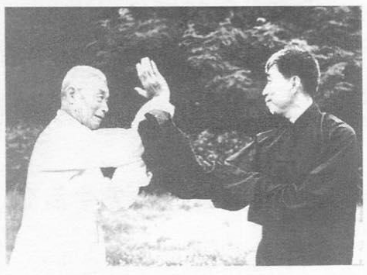
Mr. Xu Ziliang instructing Mr. Zhao Yongchang
石秀兰 (1917—1992 年), 女,山东莒县人。1924年从其兄石以群习武,后入青岛国术馆,师从杨明斋等习练孙膑拳。擅长剑术、双钩、散手、对练等拳械。1935年参加青岛国术市考,获女子全能亚军、长兵器冠军、散手冠军;同年10月代表青岛参加了旧中国的第6届全运会。新中国成立后,先后任教于青岛市上海路小学、合江路小学。曾任青岛市武术研究会委员等职。
Shi Xiulan (石秀兰; 1917-1992), female, was from Juxian, Shandong. In 1924, she began training in martial arts with her brother Shi Yiqun (石以群), and then she enrolled in QMAI, where she studied Sun Bin Boxing (孙膑拳) under Yang Mingzhai (杨明斋) and other teachers. She was adept at the sword, double hooks, sanshou, and two-person sets. In 1935, she participated in the Qingdao Martial Arts City Examination (青岛国术市考) and won first in long weapons, first in women’s sanshou, and came in second in the women’s all-around. In October of that year, she represented Qingdao at the “Old China” 6ᵗʰ Chinese National Games (第6届全运会). After the founding of the PRC, she taught in Qingdao at the Shanghai Road and Hejiang Road primary schools. She also served as a member of the Qingdao Martial Arts Research Association (青岛市武术研究会).

Image of Shi Xiulan after a competition
(To be continued…)
*Often used as a synonym for Shandong, “Qilu” (齐鲁) refers to the kingdoms of Qi and Lu, located in modern-day Shandong, traditionally regarded as one of the birthplaces of Chinese civilization.
Translated & edited by ZhongwenTranslation
Related Images
Yu Tianlu (于天路), Cheng Xianming (程显明), Zhao Yongchang (赵永昌)

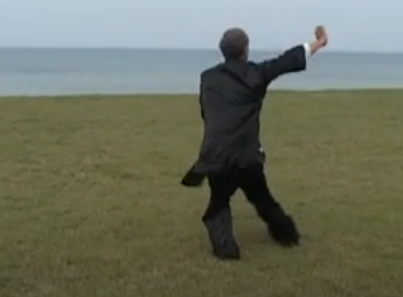
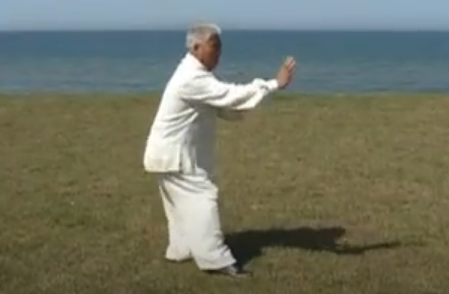
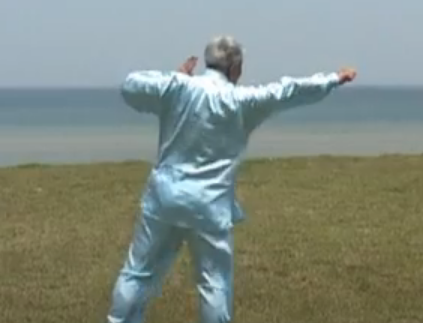

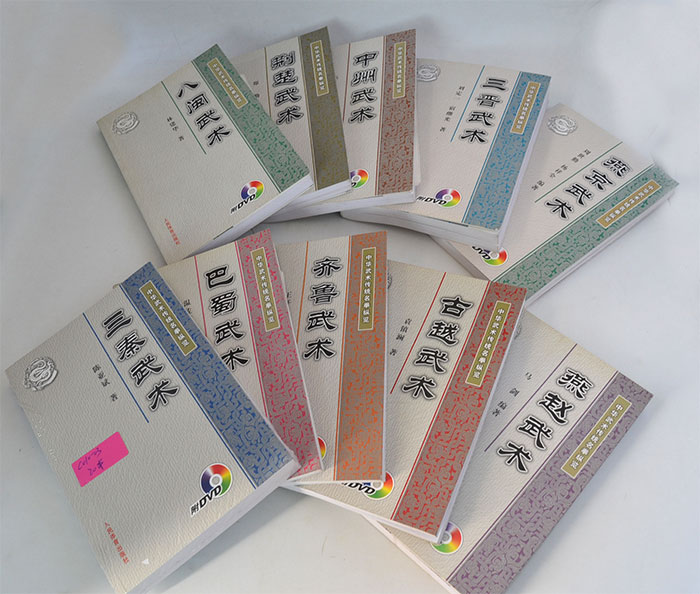
Biography of Liu Hao-Yi (2)
Hao-Yi took out a copy of that day's China Times and handed it to her father...